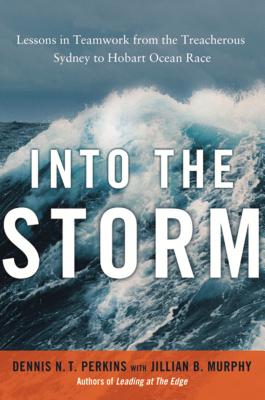Into the Storm
Sally Haldorson
November 21, 2012
Over the course of a long race, sailors will inevitably encounter setbacks. In an instant, a boat can go from leading the fleet to lagging behind. A major reversal can easily discourage the crew and, left unchecked, can deplete the crew's energy.
Over the course of a long race, sailors will inevitably encounter setbacks. In an instant, a boat can go from leading the fleet to lagging behind. A major reversal can easily discourage the crew and, left unchecked, can deplete the crew's energy. Worse yet, this weakened performance can turn into a downward spiral.Dennis Perkins, author of Into the Storm, former Marine infantry officer and amateur boater, wrote these words (with Jillian B. Murphy) about yachts in an ocean race. But the word "boat" can easily be replaced with the word "company." And the word "sailors' or "crew" can easily be replaced by the word "employees." Doing so, let's read it again.
Over the course of a long race, [employees] will inevitably encounter setbacks. In an instant, a [company] can go from leading the fleet to lagging behind. A major reversal can easily discourage the [employees] and, left unchecked, can deplete the [employees'] energy. Worse yet, this weakened performance can turn into a downward spiral.The parallels between surviving and succeeding in an endurance challenge and creating and sustaining a thriving business are clearly made in Into the Storm.
In both cases, the process of attaining success is a marathon, not a sprint. Which is true for a lot of things, but Perkins uses ocean racing--particularly the Sydney to Hobart Race, 723 treacherous miles long--because there is one thing that absolutely must be present in order to win such a race: teamwork. Only a team of racers that trusts one another and collaborates to achieve success can sustain a nearly 4-day long grueling adventure in the face of unpredictable meteorological and dangerous geological (a particularly dicey area of shallow water that is challenging even in benign weather) conditions...like in 1998 when the racers were besieged by a "weather bomb" which produced "80-foot waves and 100-mile-per-hour winds" and killed 6 sailors. Surprisingly, in the face of such environmental obstacles, the winner of that 1998 race wasn't the biggest, fastest, or strongest boat in the race. Instead, it was the 35-foot AFR Midnight Rambler with its comparably small crew. And the key to the Rambler's win? Sailing right into the storm rather than trying to skirt it like the other boats did. Which was agreed upon by each member of the team in a matter of hours, and signaled trust and complete buy-in of their common goal of completing the race. Perkins explains why good teamwork can give you every advantage in times of tough sailing.
What teams can do better than individuals is counteract the tendency to react to the emotions of the moment and make hasty, bad decisions. Every member of the team will Blink and generate ideas. But together, the team can collectively weight the options and Think, drawing on the power of team risk intelligence.Into the Storm tells the Rambler's story, and then draws out, in metaphor, how to apply the lessons to your business. For example, "Sail 60 degrees when the waves get high" which is an approach the captain of the Rambler would follow while maneuvering tough weather. The general notion is that sailing into or parallel to the waves is a recipe for disaster. Perkins explains why this helps us understand how to approach problems with our teams.
When I apply this 60 degrees metaphor to teams, I think about tasks that are so daunting that they need to be approached indirectly--but with clear forward motion. This might translate into taking on easier parts of the assignment first to gain traction. It also might mean changing timelines so there is less stress on the team. [...] Introducing the metaphor of sailing 60 degrees in a team discussion can stimulate new ways of thinking about solving tough problems.If you enjoy books that employ tales of extreme adventure to teach business lessons, you will find a lot of value in Into the Storm because it doesn't obscure the lessons within the story, but instead, puts the story to use as an illustration for successes to be found in teams. Watch this book trailer to get an "on the water" perspective of the race and its lessons.


